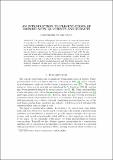Files in this item
An introduction to presentations of monoid acts : quotients and subacts
Item metadata
| dc.contributor.author | Miller, Craig | |
| dc.contributor.author | Ruskuc, Nikola | |
| dc.date.accessioned | 2020-01-27T00:34:44Z | |
| dc.date.available | 2020-01-27T00:34:44Z | |
| dc.date.issued | 2019-01-27 | |
| dc.identifier | 253280045 | |
| dc.identifier | 8ff6b47c-70a8-4568-b081-c4eaa5faab9c | |
| dc.identifier | 85060818955 | |
| dc.identifier | 000463799700026 | |
| dc.identifier.citation | Miller , C & Ruskuc , N 2019 , ' An introduction to presentations of monoid acts : quotients and subacts ' , Communications in Algebra , vol. Latest Articles . https://doi.org/10.1080/00927872.2018.1498862 | en |
| dc.identifier.issn | 0092-7872 | |
| dc.identifier.other | ORCID: /0000-0003-2415-9334/work/73702026 | |
| dc.identifier.uri | https://hdl.handle.net/10023/19357 | |
| dc.description.abstract | The purpose of this paper is to introduce the theory of presentations of monoids acts. We aim to construct ‘nice’ general presentations for various act constructions pertaining to subacts and Rees quotients. More precisely, given an M-act A and a subact B of A, on the one hand we construct presentations for Band the Rees quotient A/B using a presentation for A, and on the other hand we derive a presentation for A from presentations for B and A/B. We also construct a general presentation for the union of two subacts. From our general presentations, we deduce a number of finite presentability results. Finally, we consider the case where a subact B has finite complement in an M-act A. Weshow that if M is a finitely generated monoid and B is finitely presented, then A is finitely presented. We also show that if M belongs to a wide class of monoids, including all finitely presented monoids, then the converse also holds. | |
| dc.format.extent | 319628 | |
| dc.language.iso | eng | |
| dc.relation.ispartof | Communications in Algebra | en |
| dc.subject | Monoid act | en |
| dc.subject | Presentation | en |
| dc.subject | Subact | en |
| dc.subject | Rees quotient | en |
| dc.subject | Union | en |
| dc.subject | QA Mathematics | en |
| dc.subject | T-NDAS | en |
| dc.subject.lcc | QA | en |
| dc.title | An introduction to presentations of monoid acts : quotients and subacts | en |
| dc.type | Journal article | en |
| dc.contributor.institution | University of St Andrews. Pure Mathematics | en |
| dc.contributor.institution | University of St Andrews. School of Mathematics and Statistics | en |
| dc.identifier.doi | 10.1080/00927872.2018.1498862 | |
| dc.description.status | Peer reviewed | en |
| dc.date.embargoedUntil | 2020-01-27 | |
| dc.identifier.url | https://arxiv.org/abs/1709.08916 | en |
This item appears in the following Collection(s)
Items in the St Andrews Research Repository are protected by copyright, with all rights reserved, unless otherwise indicated.

